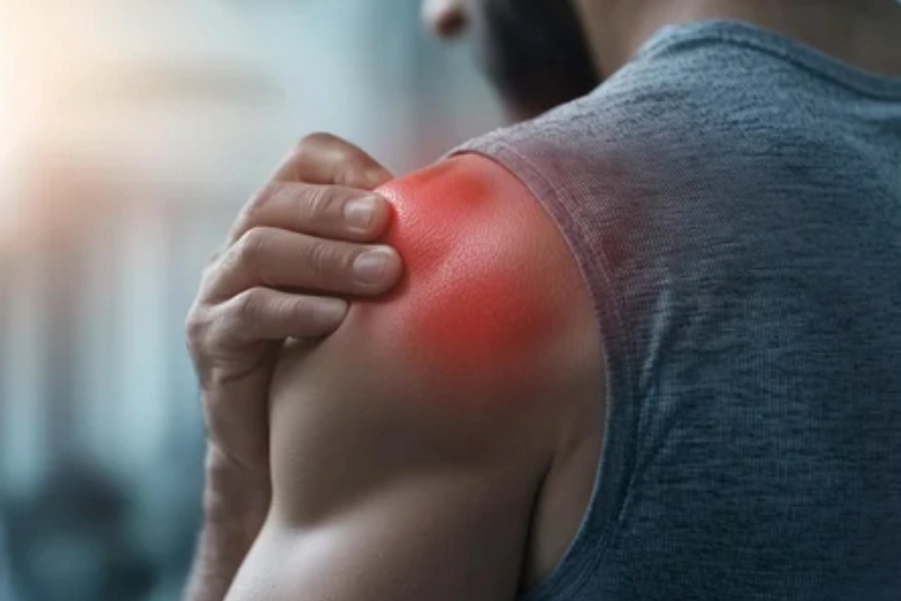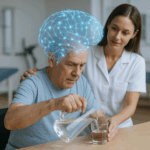Overview of Conditions:
Chronic mechanical shoulder pain is a prevalent musculoskeletal condition that lasts for more than 3 months. It often arises from repetitive stress, overuse, or degeneration of the shoulder structures, including conditions like rotator cuff tendinopathy, shoulder impingement syndrome, frozen shoulder (adhesive capsulitis), or biceps tendinopathy. The pain is generally persistent, with symptoms including dull aching, stiffness, limited range of motion (ROM), and functional impairments in movements such as lifting, reaching overhead, or performing everyday tasks.
Etiology: Chronic shoulder pain commonly results from factors such as prolonged poor posture, repetitive motions, or past acute injuries that were inadequately treated. Over time, these contribute to inflammation, degeneration, and scar tissue formation, causing long-term discomfort (Cools et al., 2021; Ray et al., 2021).
Assessment and Evaluation:
- History:
- Onset and Duration: Identify whether pain developed gradually or followed an injury. Chronic pain typically lasts for several months.
- Nature of Pain: Assess pain characteristics (e.g., dull, aching, sharp). Intermittent pain worsening over time is common in tendinopathy or impingement syndromes.
- Aggravating Factors: Activities such as lifting, overhead motions, or reaching behind the back can worsen symptoms.
- Functional Limitations: Determine how the pain affects daily activities, work tasks, or sports performance.
- Pain Assessment:
- Use the Visual Analog Scale (VAS) or Numeric Pain Rating Scale (NPRS) to measure pain intensity.
- The Disability of the Arm, Shoulder, and Hand (DASH) score can assess functional ability.
- Physical Examination:
- Postural Assessment: Check for poor posture, including rounded shoulders or forward head posture, which may contribute to pain.
- Inspection: Observe for visible signs of muscle wasting, asymmetry, or atrophy, especially in the rotator cuff or scapular muscles.
- Palpation: Feel for tenderness or swelling in structures like the acromioclavicular joint, subacromial space, rotator cuff tendons, and biceps tendon.
- Range of Motion (ROM): Assess active and passive ROM, focusing on flexion, abduction, and external rotation. Limited ROM is a hallmark of frozen shoulder or rotator cuff injury.
- Strength Testing: Test the strength of rotator cuff muscles (supraspinatus, infraspinatus, subscapularis) and scapular stabilizers (serratus anterior, lower trapezius).
- Special Tests: Use Neer’s Test, Hawkins-Kennedy Test, and Drop Arm Test to check for rotator cuff impingement or tears. The Apprehension Test can detect shoulder instability or labral issues.
Goal Setting:
Short-Term Goals:
- Reduce pain and inflammation (aim for VAS ≤ 3).
- Restore functional ROM for pain-free movements.
- Relieve muscle spasm and tightness in shoulder muscles.
- Correct postural imbalances and educate on avoiding aggravating positions.
Long-Term Goals:
- Achieve full or near-normal ROM and strength for improved function in daily tasks, work, and sports.
- Prevent recurrence by correcting postural imbalances and strengthening the shoulder girdle.
- Restore the ability to perform overhead tasks and lifting without discomfort.
- Educate the patient on self-management strategies, such as posture training, ergonomic adjustments, and home exercises.
Recommended Treatment:
Electrotherapy:
- Transcutaneous Electrical Nerve Stimulation (TENS):
- Indication: Pain relief and muscle spasm reduction.
- Parameters:
- Frequency: 80-120 Hz.
- Intensity: Comfortable, sub-threshold to moderate.
- Pulse Width: 100-300 µs.
- Duration: 20-30 minutes, 2-3 times per day.
- Mechanism: Modulates pain perception by stimulating sensory nerves, offering pain relief and reducing spasms.
- Interferential Therapy (IFT):
- Indication: Pain reduction and deeper tissue stimulation.
- Parameters:
- Frequency: 4,000 Hz carrier frequency, modulated at 80-150 Hz.
- Duration: 20-30 minutes.
- Mechanism: Stimulates deeper tissues to enhance circulation and reduce muscle spasm and pain.
- Class 4 LASER Therapy:
- Indication: Tissue repair and inflammation reduction.
- Parameters:
- Wavelength: 800-900 nm.
- Power: 5-10 W.
- Duration: 5-8 minutes per treatment area.
- Mechanism: Accelerates cellular regeneration, improves circulation, and promotes soft tissue healing.
- Ultrasound Therapy:
- Indication: Pain relief and tissue repair.
- Parameters:
- Frequency: 1 MHz (for deeper tissue penetration).
- Intensity: 0.5-1.0 W/cm².
- Duration: 5-10 minutes per area.
- Mechanism: Increases tissue temperature, promoting healing through mechanical vibrations and enhanced circulation.
Thermotherapy:
- Moist Heat Packs:
- Indication: Chronic pain and muscle tightness relief, especially in later rehabilitation phases.
- Application: Apply for 15-20 minutes, ensuring comfortable temperature.
- Mechanism: Increases blood flow, relaxes muscles, and reduces stiffness in the shoulder joint and muscles.
Manual Therapy:
- Myofascial Release:
- Indication: Muscle tightness, trigger points, and shoulder stiffness relief.
- Technique: Apply sustained, gentle pressure to affected muscles like the upper trapezius, infraspinatus, and subscapularis.
- Mechanism: Reduces muscle tension, improves flexibility, and relieves pain.
- Muscle Energy Techniques (MET):
- Indication: Flexibility improvement and shoulder joint mobility enhancement.
- Technique: Perform isometric contractions followed by passive stretching of the rotator cuff and other shoulder muscles.
- Mechanism: Uses autogenic inhibition to reduce muscle tone and lengthen muscles, enhancing ROM.
Exercise Therapy:
- Range of Motion (ROM) Exercises:
- Exercise: Pendulum swings and wall climbing.
- Duration: 5-10 repetitions, 3-4 times per day.
- Mechanism: Prevents stiffness and improves joint mobility.
- Strengthening Exercises:
- Exercise: Isometric strengthening of rotator cuff and scapular stabilizers.
- Reps: 10-15 repetitions, 2-3 sets per day.
- Progression: Gradually progress to isotonic exercises as pain decreases and mobility improves.
- Mechanism: Strengthens muscles, improving endurance and joint stability.
- Scapular Stabilization Exercises:
- Exercise: Scapular retraction and depression exercises.
- Mechanism: Strengthens scapular muscles to improve biomechanics and reduce strain on the glenohumeral joint.
Precautions:
- Electrotherapy:
- Avoid in patients with pacemakers or other implanted devices.
- Use caution in areas with compromised skin or wounds.
- Thermotherapy:
- Do not apply heat during acute inflammation (first 48-72 hours). Ensure the temperature is comfortable to avoid burns.
- Manual Therapy:
- Apply myofascial release and MET techniques gently in early recovery phases to avoid aggravating symptoms.
- Use caution with joint mobilizations in cases of hypermobility or instability.
- Exercise Therapy:
- Ensure exercises are pain-free and gradually increase intensity. Avoid overhead movements until ROM and strength improve.
- Cease exercises if pain increases during or after the session.
Reassessment and Criteria for Progression/Change in Care Plan:
- Pain Reduction:
- Pain should decrease significantly (VAS ≤ 3) within 2-4 weeks. If pain persists, reassess the treatment plan and consider further diagnostic investigations.
- ROM Improvement:
- Aim for gradual improvement in ROM. If no progress is seen after 6-8 weeks, consider more aggressive manual therapy or refer for further imaging (e.g., MRI).
- Strengthening:
- If muscle weakness persists despite exercises, progress to higher resistance levels and incorporate advanced manual therapy techniques, such as joint mobilizations.
- Functional Progress:
- Regularly reassess functional abilities (e.g., lifting, overhead reaching). If progress stagnates, modify exercises or consider adding kinesiology taping for proprioception.
References:
- Cools, A. M., et al. (2021). “Rehabilitation of shoulder impingement syndrome: A comprehensive approach.” Sports Medicine, 51(10), 1649-1663. https://doi.org/10.1007/s40279-021-01450-7
- Ray, D., et al. (2021). “Therapeutic modalities for shoulder pain: A systematic review.” Journal of Pain Research, 14, 925-940. https://doi.org/10.2147/JPR.S315399
Disclaimer:
This content is for informational purposes only and is not intended to replace professional medical advice. Always consult with a qualified healthcare provider before implementing any treatment plan.






